

In Focus : The MG ZT - Britain's Luxury Sports-Sedan
In the recent Brooklands Motors media test-drive, besides the two Rover 75 models, I also had the chance to sample the MG ZT. This is MG Rover's luxury 'sports sedan' offering. Historically the MG marque has always been associated with sports and 'sporty' cars. The first MG was created by Cecil Kimber in 1924 (though rather confusingly, other internet sources also put it at both 1923 and 1925) and was a 4 seater 'sports sedan' based on a Morris and using a 14hp Morris Oxford engine. MG 'died' for a period during the 1970s but was revived in 1995 when the then 'Rover Group' launched the famous MGF 2-seater open-top sports car. This was later rebadged as the MG TR in 2000. Today the MG marque is an entire range of models which serves as MG Rover's 'performance vehicles' line-up.
The MG ZT which is the subject of this review is the 'performance version' of the Rover 75 luxury sedan and represents what might be called MG Rover's 'sports sedan'. Launched in 2001, MG Rover sells a 7 variants line-up of the MG ZT sports sedan in the UK differing mainly in the engine, with engine sizes ranging from a 1.8l i-4 to a 4.6l V8 and including 2 turbo-diesels as well. For the Malaysian market, Brooklands Motors markets the 2.5l V6 MG ZT 180.
Brief Technical Overview

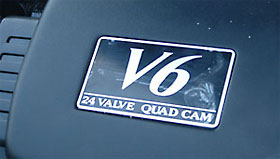
The MG ZT 180 comes with a Rover designed naturally aspirated 2.5l V6 'QOHC' engine. QOHC is a popular term used by manufacturers to signify 'Quad-Cams' and in a V6 engine is used to refer to twin banks of 3 cylinders both in DOHC configuration. There are 4 valves per cylinder (2 intake and 2 exhaust) thus making this a 'V6 24-valve QOHC' engine. The CR is a high 10.5 and max power is 177ps coming at 6,500rpm with the red-line tagged at 6750rpm. The max torque is 240Nm (24.4kgm) at 4,000rpm. With a relative 'large' engine and a respectable level of power, as would be expected the MG ZT 180 delivers quite well in the performance area, being rated for 8.9 sec for the 0-100kph dash with a rated max speed at 215kph (134mph).

The MG ZT 180 uses the same JATCO 5speed automatic gearbox as the Rover 75s which is re-tuned for more 'sporty driving' meaning more eagerness to downshift in heavy throttle positions and also a tendency to hold the gear longer. As with the Rover 75, the gearbox is well equipped, fitted with four forward gates : 2, 3, 4 and 'D' as well as the 3 driving modes of economy, sports and winter. Disappointingly despite its blatant packaging as a performance oriented 'sports sedan', Rover did not equip the gearbox with a manual sequential shifter option. While the gearbox is more than adequate for a luxury sedan like the Rover 75, a sequential shifter really is more or less a mandatory feature in today's sporty oriented auto-gearbox'ed vehicles.

The MG ZT 180's suspension system is also the same as the Rover 75, front strut-rear independent system but it has been significantly upgraded. Firstly the car's bodyshell is more rigid than the Rover 75's. According to the MG brochure, the front Macpherson strut uses gas-filled dampers with 'auxiliary rebound' springs (I think this means dual layer springs) and they are tuned in conjunction with 'unusually high rate' anti-roll bars. The brochure mentions a special rear-facing 'L-shaped' lower arm and special bushings for accurate toe control while the entire front suspension including the steering rack rides on an extra stiff peripheral sub-frame that is mounted to the body for better isolation. The target is 'excellent body control' without a trace of 'float or heave'. In the rear. the 'Z-axle' independent system with coil spring and dampers is retained. Even the power steering uses a 'fast ratio' and has been 'sports calibrated' for improved feedback. Indeed these kind of attention to details is nicely reminiscent of what Honda usually puts into its sporty vehicles !
The brake system are extra sized front ventilated and rear solid discs fitted with a Borsch 4-channel ABS with EBD. The test car is fitted with the optional 18" wheels with large 225/45 R 18 tyres. This gives the MG ZT a purposeful and 'fast' look. Interior wise, the car is the same showcase for 'British design' as the Rover 75s. The interior is fully leathered but is now a dark theme interior more suitable for a sports sedan. Being a CBU (fully imported), the MG ZT comes with a rather hefty price tag of RM200k (~US$50k) but from a subjective point of view, the level of attention and technology details that MG Rover put into building this MG ZT goes some way to justifying the extra RM40k price tag compared to the asking price (160k) of the equivalent Rover 2.0 V6.
Test-Drive Impressions
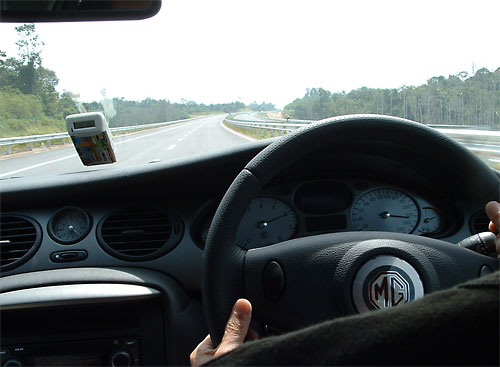
Since my experience with the MG ZT was in the same media test-drive session as the Rover-75s, it was thus mainly on expressway travel. The MG-ZT was actually the 2nd car in our 'to' portion of the trip and my experience of it was right after the Rover 75 1.8 Turbo. The sequence of drivers was the same as the Rover 75 1.8 Turbo so I was the 2nd person to take over the wheels.
I took over the wheels to the MG ZT at a rest-area. Powering out of the rest-area allowed me to immediately sample it's pick-up. Here, the large 2.5l engine gives the ZT good acceleration, accompanied by a nice 'v6' whine as well. The engine revs right up to the redline on the tach before shifting and the ample, wide power band allowed me to merge effortlessly into the expressway. The part of the expressway I was driving at while in good condition is not totally level and there are sections of uphill and downhill as well. The 'sporty' tuning of the JATCO gearbox is useful here as I did not need to bother with playing with throttle positions during the uphill part - just keep the throttle planted on the floor in 'S-mode' and the gearbox automatically downshifts when the car's speed starts to slow down. The gearbox tuning is much more 'aggressive' compared to the Rover 75s, both the 1.8 Turbo and the 2.0 V6. The gearbox downshifts at the slightest excuse and during WOT, the gear position is held even when the throttle has been eased by quite a lot. S mode is more aggressive than D as would be expected, with the gearbox operating as a 4-speed unit just like the Rover 75s. As would be expected from a true sports-sedan, the ZT's brakes are nice and firm, giving very confident braking power. Brake pedal feel is pleasingly linear as well.
 |
 |
 |
As would be expected from the amount of details that went into it, the MG ZT 180's suspension follows the same aggressive sporty theme. Over the expressway roads, the setting is such that the ZT tracks the contours of the roads rather faithfully, in a way 'pitching' about according to the undulations of the road. Road imperfections are also transmitted quite clearly to the driver. As a result, coming from the relative comfort of the Rover 75, driving the ZT over the expressway is a huge contrast as the driver is continously presented with large amounts of 'information' about the road's condition. It is not jarring or uncomfortable however and the driving enthusiast would call it 'communicative' as in the car communicates the condition of the road to the driver quite clearly. And as would be expected from its continental 'pedigree', the MG ZT has excellent high speed stability. So in a way, the ZT made the trip a 'driving experience' rather than a 'journey'. In the limited amount of twisty roads I could experience, the ZT exhibited little body roll. It is not as rock solid as a Type-R but still in this sense it do feel similar to Honda's sporty models like the SiR or even a milder version of our Type-Rs. The steering feels great in the twisty parts, the car responding wonderfully to input at the steering wheel and the feedback feels nicely weighted. In a way, it reminds me of the steering feel of the (JDM) Honda S2000 that I feel in love with earlier this year when one of my club members so generously allowed me to take his car for a couple of 'laps' around the block.
Like the best continental cars, what the MG ZT truly excelled in was its supreme stability at high speeds. One of the journalists in my group tested the MG ZT's top speed during his turn at the wheels. With 4 full adults on board and over a particularly straight and quiet stretch of the expressway with mild up and down inclines, we were actually able to exceed the rated top speed, and reached an indicated 225kph (140mph) on the speedometer a few times. As an indication of the stability of the MG ZT at this high speed, I was able to take a few photos during our progress to that speed. I took photos when the car was at 200, 210, 220 and finally 225kph. The lead photo for this section above shows the speedo needle tagging the 225kph mark. Note how focussed the photo is which shows how utterly stable the MG ZT was at that speed. The series of photos on the right are extracted from other shots from the same photo angle but of the speedo meter at speeds of 200, 210, and 220kph. I selected the area of the photo around the speedo, cropped it and then reduced the size. Notice how easy it is to read the speedometer's face and how clear and focussed the image is, even after the degradation from the reduction in image size. This is direct illustration of the stability and poise of the MG ZT which allowed me to hold my Fuji camera steady enough to snap the photos. Remember I was sitting at the back seats behind the front passenger !
For this media trip, as I am not familiar with the Brooklands Motors staff, I did not bring my trusty GTECH PRO with me as I am not sure how they would react to me doing standing start launches with tyres squealing and engine roaring to the rev-cut. So unfortunately I was not able to conduct any impromptu tests to confirm if MG's figures for the ZT's 0-100kph acceleration of 8.9 seconds is accurate or not.
Comparison with Honda Models

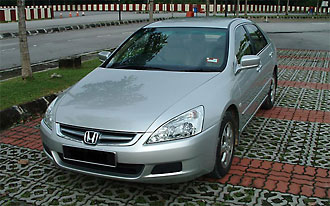
Size-wise, the MG ZT is the same as the Rover 75 at 4749mm by 1761mm by 1393mm (L X W X H). So in terms of size and specifications, the MG ZT again competes against the Honda Accord, more specifically the Accord 2.4 i-VTEC in the Asian region. While the Accord 2.4 i-VTEC has a lower max power, a lighter bodyweight and subjectively higher gear ratios allows it to be be about as fast as the MG ZT over straight-line acceleration runs; based on my own GTECH test results for the Accord 2.4 i-VTEC (0-60mph at 8.7s) as compared to MG Rover's own published figures for the ZT (0-60mph at 8.9s as published on the MG Rover U.K. website). However the Asian (US-bodied) Accord is conceptualized as a 'luxury sedan' so its suspension is tuned to be softer for more comfortable high speed cruising. As a result, the Accord 2.4 i-VTEC does not handle as well as the MG ZT and dissappointingly does not exhibit the same level of stability at high speeds as well. I remember a trace of lightness at the steering wheel once speeds exceed 200kph on the Accord 2.4 i-VTEC when I had it for testing whereas the MG ZT was still rock solid even when I exceeded 200kph with it.
But the real problem with comparing the MG ZT and Accord 2.4 i-VTEC really is that I am breaking my own principles of judging a car by its design objective here, because the MG ZT and the Accord 2.4 i-VTEC really have two quite different sets of design objective. Again, the MG ZT is a 'sports-sedan' while the Accord 2.4 i-VTEC is a 'luxury sedan'. So in the end, the sad fact is that for most parts of Asia, there really is no offering from Honda for this rather important segment of the market which is a higher-end (higher priced) sports-sedan targeted at driving enthusiasts. Indeed in terms of concept, it is really very ironic that the closest model Honda markets for Asia is the little City VTEC which of course is in a completely different market segment as compared with this MG ZT.
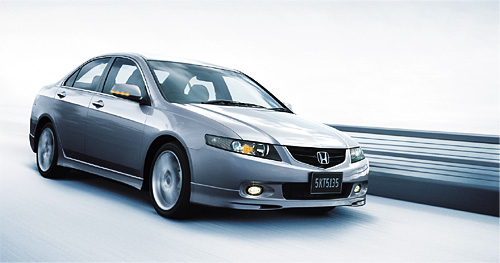
If we look at the whole Honda line-up worldwide though, there are Accord variants that competes head-on with the MG ZT. Selected Asian countries like Australia and New Zealand markets an 'Accord Euro' and this is similar to the JDM and European Accord and the US Acura TSX. The 2.4l auto versions of this model would actually be the most direct competitor to this MG ZT. Unfortunately I do not have any driving experience with the current generation 2.4l JDM-Euro Accord/ TSX. In terms of pure specs however, it is very well equipped. Using a slightly 'smaller' 2.4l engine in DOHC and i-VTEC configuration, the car delivers 190-200ps. The auto version comes with a 5AT which is equipped with a sequential shifter. The JDM/Euro Accord/ TSX is also equipped with double wishbone suspensions front and rear and its entire set-up is biased towards performance and handling, i.e. a true 'sports-sedan'. Thus specs-wise the K24A JDM/Euro Accord/ TSX will compare very favorably with the MG ZT. But until I have a chance to actually drive it, I will of course not be able to comment on the relative performance of the cars.
Conclusion
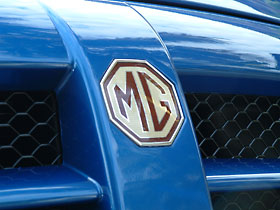
The MG ZT is an excellent representative of a higher-end 'sports sedan' done the 'continental way'. It has a fairly big engine with a good level of power which gives good overall performance and of course an outstanding high speed stability. It is not perfect from the enthusiast's set of wishes though because like most people in the (ASEAN) region, Brooklands Motors markets only the auto version and even that does not come with a sequential shifting mode. With even the latest Volvo S40 2.4, a marque traditionally held to be the perfect epitome of the old man's car now offering 5speed auto gearboxes with sequential shifters, the lack of this option for a sports sedan targeted at driving enthusiasts is to be honest dissapointing.
Nevertheless, the MG ZT is really an excellent sports sedan and as a driving enthusiast, I really enjoyed driving the MG ZT for its sporty performance. If I am in the market for a CBU sports-sedan, I would certainly consider the MG ZT very seriously. As a Honda enthusiast, I really, REALLY wish Honda has such an offering for the local region. Honda has always been about performance and the driving experience, and the Asian region is really the only major Honda market that does not have a 'sports-sedan'. Very sadly, the truth is that Honda does not see fit to market a luxury 'sports sedan' for the Asian region, deeming it as being 'niche' market. This has of course been a source of great complaint by Honda fans for a number of years, a complaint that the Temple of VTEC Asia has been most vocal in delivering. Sadly, the lack of such a model has also the cause for a number of Honda fans to move away from Honda ownership, typically to BMW's and Audi's as these offers the package of sporty sedan that they are looking for that frankly is not available from the Asian Accords. My appetite has already been whetted greatly by this excellent offering from MG so I can only hope the Honda will see fit to offer a similar model for all of Asia in the near future.
Wong KN
November 2004
© the Temple of VTEC Asia